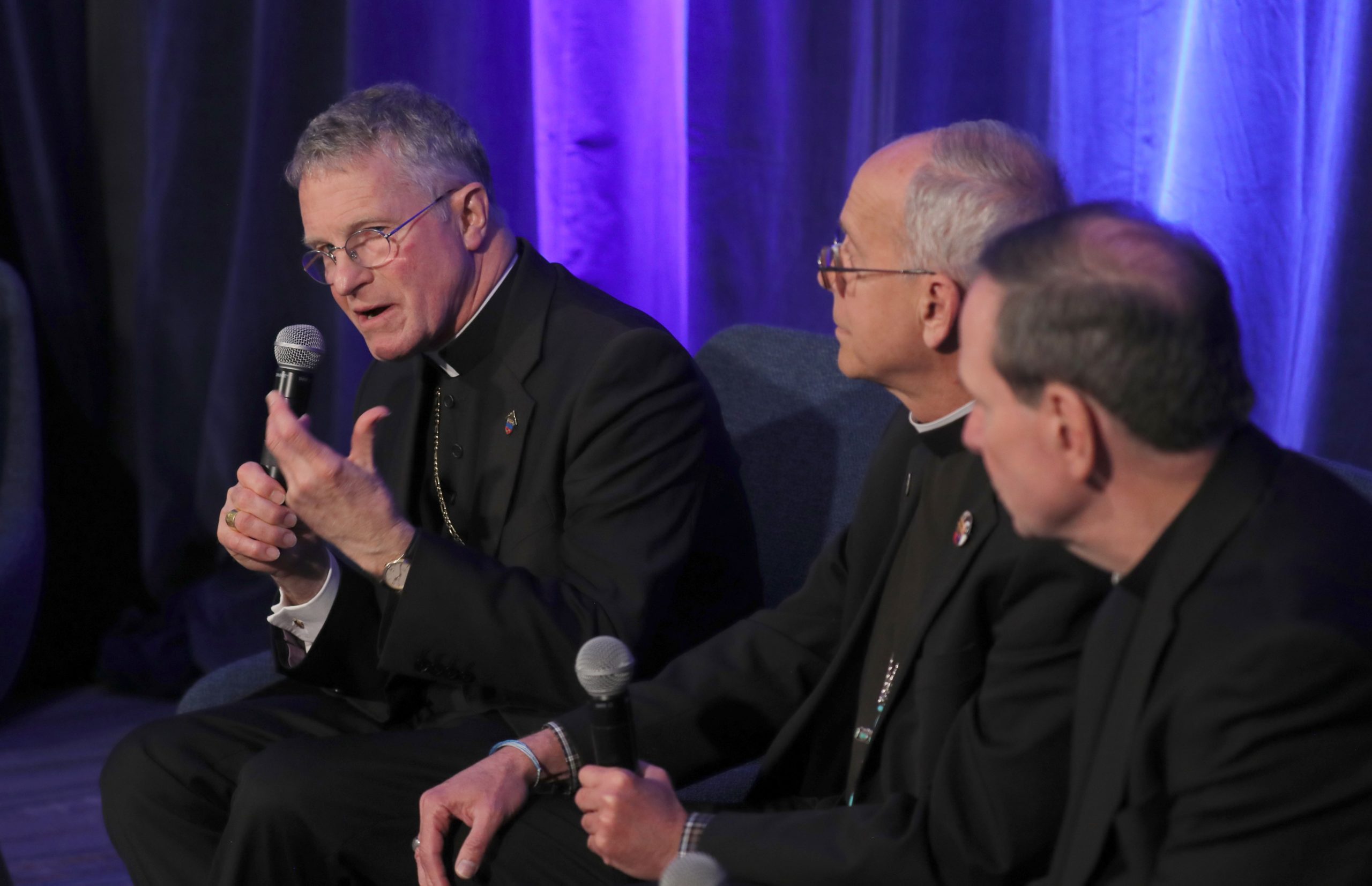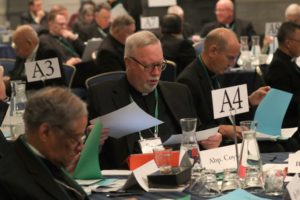The U.S. Catholic bishops’ fall meeting this year played out in the shadow of Donald Trump’s election as the nation’s next president and the conclusion of Pope Francis’ signature initiative for the universal Church, the Synod of Bishops on Synodality in Rome.
By the end of the meeting, held Nov. 11-14 in Baltimore, it was clear that both decisive events, the ecclesial and the political, will shape the bishops’ agendas in the months and years ahead.
Trump’s victory, which included the Republican Party’s capture of both the House and the Senate, means there will be areas of obvious agreement between the U.S. Conference of Catholic Bishops and the next administration, like religious liberty protections for Catholic schools and hospitals facing mandates related to abortion, contraception, and transgender issues.
But in Baltimore, the bishops’ attention seemed more focused on the less palatable aspect of Trump’s 2024 platform: a campaign pledge to tighten the U.S.-Mexico border and potentially deport millions of undocumented immigrants — a position that Pope Francis has equated with the extreme pro-abortion stance of Trump’s opponent, Vice President Kamala Harris.
During the bishops’ meeting, there were indications that immigration could be the issue that defines Catholic relations with the new Trump administration.
Asked how the bishops would respond to the planned deportations, the USCCB’s migration chairman sounded a cautious note.
“We are waiting to see just exactly what takes shape,” said Bishop Mark Seitz of El Paso at a Nov. 12 news conference. “We know very often the reality is different than the rhetoric, and so we’ll watch and respond as needed.”

During the first Trump administration, Seitz was a leading voice against the separation of migrant families apprehended along the U.S.-Mexico border. More recently, he has publicly challenged Texas Gov. Greg Abbott’s attempts to expand the state’s authority over immigration enforcement. But days after Trump’s election, Seitz told journalists in Baltimore “there will still be areas where we can collaborate” with the White House and lawmakers.
Hinting at the hurdles Trump’s deportation plans could encounter in courts, Seitz said it was important that any processes “unfold in a legal way” and that immigrants’ “basic human rights” be respected.
“We think that this is going to be a test for our nation,” said Seitz. “Are we, in fact, a nation based on the most fundamental laws about the rights of a human person, or are we not?”
In his opening address, conference president Archbishop Timothy Broglio drew a rare round of applause from the bishops in the room after declaring they would be “unstinting” in their commitment to “see Christ in those who are most in need,” including “those who cross the country’s borders.”
“We certainly do not encourage illegal immigration, but we will all have to stand before the Throne of Grace and hear the Lord ask us if we saw him in the hungry, thirsty, naked, homeless, stranger, or sick and responded to his needs,” said Broglio, who leads the Archdiocese for Military Services.
Meanwhile, there was no explicit mention at the meeting of Trump’s stated support for a federal insurance mandate for in vitro fertilization, a practice that violates the Church’s teaching on the sanctity of life, or Vice President-elect J.D. Vance’s support for wider access to the abortion pill mifepristone. Both proposals would put Vance, a practicing Catholic, at odds with the moral teachings of his own faith, much like President Biden’s support for legal abortion did.

There was also little sense that the bishops had a clear plan on how to implement the recently concluded Synod on Synodality’s final document, which called for greater lay participation in decision-making processes and structural changes to some areas of Church governance.
As the U.S. bishops’ designated point person on the synod, Bishop Daniel Flores of Brownsville, Texas, told the bishops, many of the synod’s recommendations “involve habits of ecclesial life that are already a part of our practice” in the United States.
Broglio, who participated in the synod along with several other American bishops, also made a similar point in his presidential address. But he also took a not-so-subtle swipe at the “campaign positions that sometimes colored the approaches of certain participants” at the synod.
“There is still an occasional sentiment that if I do not get what I want, the Church is not being synodal,” said Broglio, who was presumably referring to the push among some synod delegates for changes in approach to so-called “LGBTQ+ issues” and women’s leadership. “We have to grow in our understanding and in our ability to listen to the Holy Spirit.”
While the synod addressed wider participation in the processes that go into “decision making,” Flores stressed that decision “taking” remains another matter.
“Decisions, we know, need to be made at appropriate levels,” said Flores. “Some matters, affecting the life of the whole diocesan church, only the bishop can take.”

Later, he added: “Synodality does not represent a retreat from episcopal responsibilities; it is an invigoration of them.”
During the ensuing floor discussion on synodality, Synod delegate Cardinal Robert McElroy of San Diego repeated his recent proposal that the conference should establish a “task force on synodality” to advise the conference on how to become more “synodal” — and suggested that Flores lead it.
When fellow Synod delegate Cardinal Blase Cupich of Chicago asked Broglio to hold a voice vote to gauge interest in the idea, the proposal passed easily. But exactly what role the task force, if created, will play is hard to predict. Judging from statements (both public and private) made by American bishops who attended the synod, what “synodality” means for the U.S. Church depends on who you ask.
Probably adding to the sense of uncertainty at the bishops’ meeting was that with so many dioceses due for new leadership, their ranks will be looking a bit different soon: There are currently five U.S. dioceses considered “vacant sees,” meaning they are not led by a bishop, and another 20 whose current bishops have reached the traditional retirement age of 75 and are due to be replaced by Pope Francis.

